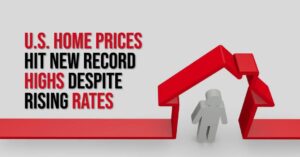US home price growth is slowing down! Is a price decline coming in some markets? If you're thinking about buying a house, here's a breakdown of the latest data to help you make informed decisions. This article dives into national trends and highlights specific areas to watch.
Nationally, home prices are still on the rise, but the pace is slowing. As of April 2024, year-over-year growth sits at 5.3%, according to CoreLogic. That's a healthy increase, but down from the double-digit figures we saw in some parts of the country last year. This moderation is likely due to a combination of factors, including:
- More homes becoming available: In some areas, there's been an increase in listings, giving buyers more options.
- Higher interest rates: Mortgage rates are hovering around 7%, making monthly payments more expensive for potential buyers.
Current Housing Market Trends
As of April 2024, home prices nationwide, inclusive of distressed sales, witnessed a notable year-over-year increase of 5.3% compared to April 2023. Moreover, on a month-over-month basis, home prices surged by 1.1% from March 2024.
It's essential to recognize that revisions with public records data are standard practice in the industry. To uphold accuracy, entities like CoreLogic incorporate newly released public data to provide updated results.
Predictions for Home Prices
What's the forecast for the future?
The CoreLogic Home Price Index (HPI) Forecast paints a picture of continued growth. It suggests that home prices are poised to rise by 0.8% from April 2024 to May 2024, with a substantial 3.4% increase expected on a year-over-year basis from April 2024 to April 2025.
Charting the Path Forward
Looking ahead, the trajectory of home price growth indicates a cooling trend by spring 2025. While annual appreciation stood above 5% in April, projections suggest a slowdown to 3.4% nationally. Only a handful of states are anticipated to witness increases surpassing 6%.
This moderation is attributed to various factors, including the increasing availability of homes on the market in certain regions and the prevailing 7% average for 30-year fixed-rate mortgages. These mortgage rates significantly impact America's ongoing housing affordability challenges.
Expert Insights
Here are some key takeaways from Dr. Selma Hepp, Chief Economist at CoreLogic:
- The strong performance of the spring market in 2023 is still influencing the year-over-year numbers.
- Rising interest rates have cooled down some of the usual spring buying frenzy.
- Buyers are becoming more sensitive to affordability challenges as rates rise.
- Markets with a surge in new listings or construction, and areas with significant increases in homeowner costs, are seeing a more pronounced slowdown in price growth.
Regional Variances
The CoreLogic HPI delves into regional nuances, offering insights into state-level trends. Nationally, home prices surged by 5.3% year over year in April 2024, with no states reporting declines. New Hampshire, New Jersey, and South Dakota led the pack with the highest annual increases, ranging from 10.8% to 12%.
Metropolitan Dynamics
Metropolitan areas play a pivotal role in shaping the real estate landscape. Examining home price changes across ten select metros in April 2024 reveals intriguing dynamics. San Diego topped the list with a substantial 9.9% year-over-year gain.
Is There a Chance of Price Declines?
The CoreLogic Market Risk Indicator (MRI) identifies markets potentially vulnerable to home price declines. Palm Bay-Melbourne-Titusville, FL emerges as a high-risk area, with a probability exceeding 70% for a price downturn in the next 12 months. Other areas, including Atlanta-Sandy Springs-Roswell, GA, Spokane-Spokane Valley, WA, and Deltona-Daytona Beach-Ormond Beach, FL, also warrant attention due to their susceptibility to price declines.
The Takeaway?
The US housing market is still experiencing growth but at a more moderate pace. This is welcome news for affordability. If you're a potential buyer, do your research and consider how rising interest rates might affect your monthly payment. By staying informed about national trends and specific market conditions, you'll be in a strong position to make smart decisions about your home purchase.
ALSO READ:
Housing Market Predictions for Next 5 Years (2024-2028)
Housing Market Predictions for the Next 2 Years
Housing Market Predictions for 2024 and 2025 Remain Critical
Real Estate Forecast for the Next 5 Years: Future Predictions?


 Home prices rose by 0.1% in September from the prior month and by 3.6% from one year ago, the largest gain in six years, according to a report released Monday by Lender Processing Services.
Home prices rose by 0.1% in September from the prior month and by 3.6% from one year ago, the largest gain in six years, according to a report released Monday by Lender Processing Services. Sixty-five percent of U.S. housing markets are worse off today than they were four years ago according to the California-based real estate research firm RealtyTrac.
Sixty-five percent of U.S. housing markets are worse off today than they were four years ago according to the California-based real estate research firm RealtyTrac.

 It took the Wall Street Journal
It took the Wall Street Journal 